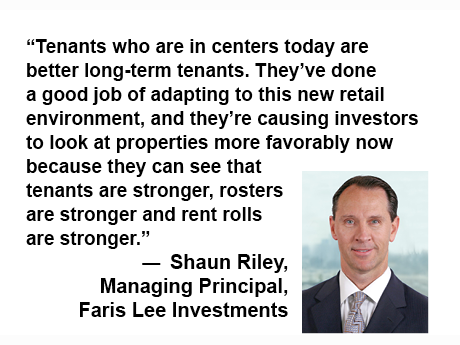
Jeff Conover,
Faris Lee Investments
Multifamily and industrial may be the hottest product types for investors in today’s current market, but Jeff Conover and Shaun Riley, managing principals at Irvine, Calif.-based Faris Lee Investments, believe retail presents the optimum opportunity for achieving strong cash-on-cash yields for investors.
“It comes down to one thing,” explains Conover. “Higher yield.”
Triple-net leases also mean expenses get passed down to the tenant. Speaking of tenants, Riley notes that tenant rosters are stronger than ever nowadays. The pandemic culled the herd a bit, so to speak, but the tenants who were able to persevere during the toughest period in retail have honed their operations.

Don MacLellan,
Faris Lee Investments
What fills shopping centers now are tenants who are the best-in-class operators.
“Tenants who are in centers today are better long-term tenants,” Riley says. “They’ve done a good job of adapting to this new retail environment, and they’re causing investors to look at properties more favorably now because investors can see that tenants are stronger, rosters are stronger operators and, accordingly, the rent roll represents better long-term stability.”
Shopping for Benefits
These stronger tenants are benefitting retail landlords and investors as a flight to quality is currently occurring, Riley notes.
“A lot of tenants are moving up the food chain,” he says. “Maybe they’ve wanted to be in a center for a long time but couldn’t manage the rent or couldn’t get in due to lack of space. Many are taking advantage of vacancies – something landlords shouldn’t be afraid of.”
“Vacancy” has always been a bad word in retail real estate…until now, Riley argues. That’s because these empty spaces can accommodate the stronger batch of tenants looking to penetrate or expand in a market. He points to Dollar Store, among others, as a prime example of this.
“Dollar Stores are grabbing vacancies in centers where they can come in and combine a few spaces together,” Riley says. “Chipotle, Panera, even some of the larger franchisees for T-Mobile and AT&T are expanding to sites they’ve wanted to be in for a long time. Now, those leases are getting signed.”
Vacancies also give investors the chance to increase cash flow as the property is stabilized. That was one of the benefits a private investor who recently moved to Orange County, Calif., was able to realize when they purchased La Paz Shopping Center in Laguna Niguel, Calif., for $14 million in March. The center was anchored by Walgreens but had a few vacant suites at the time of sale.
Wild Fork Foods, a relatively new meat and seafood market that opened its first locations in South Florida, signed a long-term lease that was executed at close of escrow.
The property generated multiple offers and closed at a 4.88 percent cap, one of the lowest cap rates in Orange County for a retail investment over $10 million. Faris Lee represented both the buyer and seller, a Newport Beach, Calif.-based large investment company private office, in the transaction.
Investments in retail real estate can be an inflation hedge for investors, Riley also points out, if Consumer Price Index (CPI) increases are built into leases. With inflation being what it is today, these CPI increases can be extremely beneficial to landlords, particularly if they don’t have ceilings.
“For shop tenants that aren’t national credit, these rent increases tend to be annual rental increases,” Riley adds. “If you don’t have fixed increases, the owner is able to structure CPI increases, which can pass the cost of living increases onto the tenants. In this way, retail real estate is an ideal hedge against inflation.”
Investing with Enthusiasm
CPI clauses can provide some room to grow — an attractive feature for many investors who haven’t seen a lot of runway in other product types.
“When you look at the cap rates of core retail versus core industrial, retail can be up to 200-plus basis points higher than industrial,” Conover says. “There’s a premium spread on retail.”
Conover further notes demand for retail remains high. There are investors priced out of the industrial and multifamily markets, as well as office investors who don’t currently see opportunity in that sector and new retail investors who have money on hand. These investor pools are, of course, mixed in with traditional retail real estate investors.
“There’s been an abundance of wealth creation post-pandemic,” Conover says. “In 2020, the money was on hold. Everyone was frozen. All that pent-up demand went to work in 2021. Everyone is getting off the sidelines, and the chips are being played. Investors run the full gamut from institutional, private, family office, REITs. There’s just a lack of opportunities and an abundance of capital chasing them right now.”
Competition may be fierce, but Conover believes there’s a place for every type of investor in this market, including new retail investors coming to the table.
“The two-to-five-tenant strip center is probably where I would advise a new buyer to invest,” he says. “It has higher yield potential, while the risk factor isn’t quite as big as it is in a larger, multi-tenant center. Plus, you can manage two to five tenants fairly easily versus having to hire an outside management company.”
Riley agrees. He notes that while location may be important for all commercial investments, it has and will always be the primary pillar of retail.
“It’s the purest form of real estate based off location, location, location,” he says. “Did you find the right location? That is still the biggest question investors need to answer and get comfortable with, despite all the changes in retail real estate.”
— By Nellie Day. This post is posted as part of Shopping Center Business’ Retail Insight series. Click here to subscribe to the Retail Insight newsletter, a four-part newsletter series, followed by video interviews delivered to your inbox in May/June.


